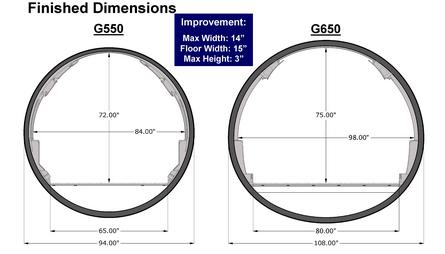Design of the G650 started with the cabin, Gulfstream says. Larger than the G550’s, the fuselage cross-section is not circular, but is instead shaped to provide the widest cabin with the minimum drag.
“We used the floor as structure and played around with the cross-section to get what we wanted while minimizing the wetted area,” says Pres Henne, senior executive vice-president programmes, engineering and test.
Gulftream started out by splitting the G550 cabin down the middle and adding a lateral “stretch”, as it has done with the G150, “but that was quickly tossed”, he says. In the final design, the bottom of the fuselage is flattened to remove wetted area and reduce drag.

Improvements are made throughout the cabin. The signature oval windows are 16% larger, mounted higher in the fuselage and set further apart to allow seat pitch to be increased. There is one more window one each side, for a total of 16.
Overall, the G650 cabin has 28% more volume and 30% more floor area than the G550. The allows a more appropriate crew rest area behind the cockpit, but still provides room for bigger seats, wider aisle, larger conference table, the option for a stateroom with bed, and a larger baggage compartment that is accessible in flight.

Gulfstream is offering a choice of 12 pre-engineered floorplans. Seating from 11 to 18 people, these all provide three living areas – 3.5 when there is no crew rest area.
In addition to the low cabin altitude – 4,850ft at 51,000ft and 2,765ft and 41,000ft – which reduces fatigue, Gulfstream says it is working to reduce environmental control system noise. Humidity control is still being looked at, Henne says.
Source: FlightGlobal.com



















